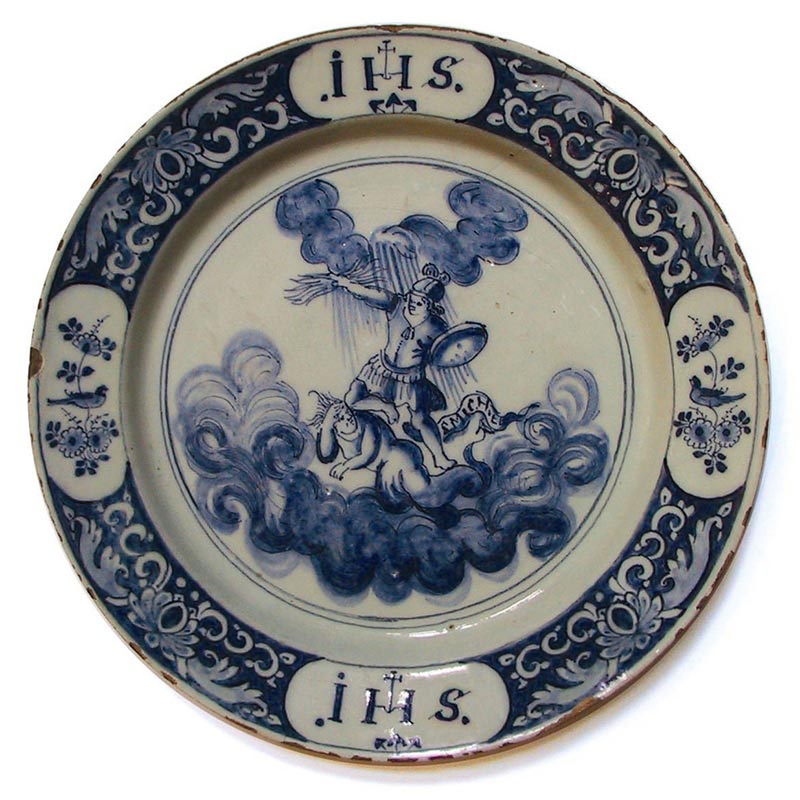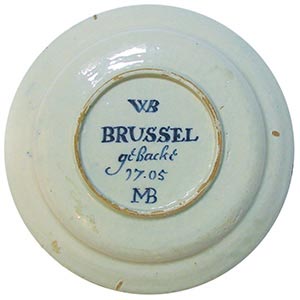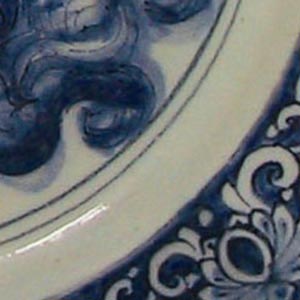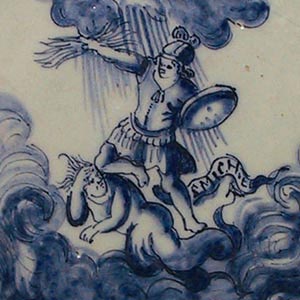
Earthenware from Brussels. Mombaers workshop, 1705.
Early days of earthenware in Brussels
 The back of the plate shows the date ‘1705’ preceded by the words ‘BRUSSEL gebackt’ (meaning ‘fired in Brussels’), while everything is framed by two pairs of letters, referring to Corneille Mombaers (MB) who, in partnership with the Dutchman Dierick Witsemburgh, (WB) opened an earthenware workshop in Brussels. In the wake of one or two unsuccessful ventures in the 17th century, earthenware production became a standard bearer for the applied arts in Brussels during the 18th century.
The back of the plate shows the date ‘1705’ preceded by the words ‘BRUSSEL gebackt’ (meaning ‘fired in Brussels’), while everything is framed by two pairs of letters, referring to Corneille Mombaers (MB) who, in partnership with the Dutchman Dierick Witsemburgh, (WB) opened an earthenware workshop in Brussels. In the wake of one or two unsuccessful ventures in the 17th century, earthenware production became a standard bearer for the applied arts in Brussels during the 18th century.
In blue and white, as in Delft… and in China
 The bright blue and white colours deployed are obviously meant to imitate the Delft-ware made in Holland, whose economic success was the envy of all. The Dutch crockery itself drew its inspiration from specimens of Chinese porcelain, which were much-sought-after at the time. The Chinese influence is also visible on the edge of the plate, where the ornamental patterns create a mixture of birds and flowers.
The bright blue and white colours deployed are obviously meant to imitate the Delft-ware made in Holland, whose economic success was the envy of all. The Dutch crockery itself drew its inspiration from specimens of Chinese porcelain, which were much-sought-after at the time. The Chinese influence is also visible on the edge of the plate, where the ornamental patterns create a mixture of birds and flowers.
St. Michael from Brussels
 In the middle, the archangel, dressed like a Roman soldier, appears in a misty circle of light. He is using lightening to strike down a demon, who is half-man, half-beast. This struggle between Good and Evil is indicative of the religious tradition referred to here by the initials IHS (meaning Jesus Christ our Saviour). The choice of St. Michael is presumably also a tribute to the Brussels City authorities, whose official symbol has been the archangel since the Middle Ages. With the aim of revitalising the local economy, the authorities provided a great deal of support in helping to facilitate Corneille Mombaers' earthenware manufacturing activities.
In the middle, the archangel, dressed like a Roman soldier, appears in a misty circle of light. He is using lightening to strike down a demon, who is half-man, half-beast. This struggle between Good and Evil is indicative of the religious tradition referred to here by the initials IHS (meaning Jesus Christ our Saviour). The choice of St. Michael is presumably also a tribute to the Brussels City authorities, whose official symbol has been the archangel since the Middle Ages. With the aim of revitalising the local economy, the authorities provided a great deal of support in helping to facilitate Corneille Mombaers' earthenware manufacturing activities.
Next step
Continue your visit by going along the long corridor that leads you to the porcelain room. These works differ from pottery in terms of their translucency and level of finesse. But they are also more robust than pottery. The commented work is a plate displayed in the last display case on the right at the back of the room.




